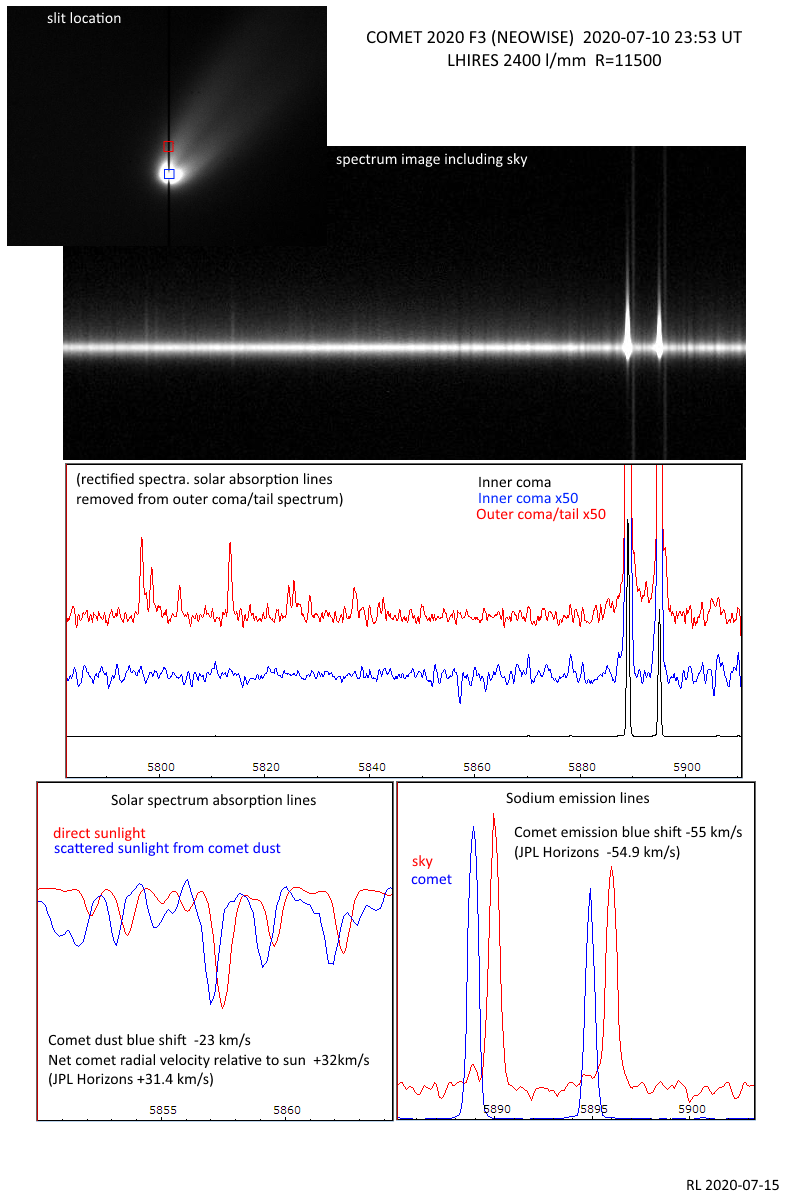Observation by Robin Leadbeater: C 2020 F3 NEOWISE Doppler velocities fro...
Uploaded by
Robin Leadbeater
Observer
Robin Leadbeater
Observed
2020 Jul 10 - 22:53
Uploaded
2020 Jul 16 - 00:32
Objects
C/2020 F3 (NEOWISE)
Spectrum
Equipment
- LHIRES III spectrograph 2400l/mm
- ATIK 314 camera
- Celestron C11 280mm aperture SCT
Exposure
3x300 sec
Location
Three Hills Observatory Wigton Cumbria UK
Target name
C/2020 F3 (NEOWISE)
Title
C 2020 F3 NEOWISE Doppler velocities from high resolution spectrum
About this image
A high resolution (~0.5A) spectrum covering the yellow part of the spectrum including the sodium D doublet wavelengths.
The Sodium emission dominates the spectrum. (There is as much light from the two narrow sodium lines as in the rest of the light in this spectrum combined.) There are no other strong emission lines in this yellow part of the spectrum (the Swan bands are further to the blue-green) but there are some other faint emission lines though which I have not yet been able to identify.
We can measure Doppler shifts to calculate the comet's motion both relative to us and to the Sun using the sodium light pollution and daylight spectrum as references
The Doppler shift in the sodium emission lines gives the velocity relative to Earth directly = -55 km/s (ie the comet is moving towards us)
We see the Sun's absorption line spectrum in the sunlight scattered from the comet dust. These absorption lines experience two Doppler shifts, first due to the motion relative to the Sun and then after scattering due to the motion relative to Earth. This total shift = -23km/s
The motion of the comet relative to the Sun is therefore -23 +55 = +32 km/s (ie the comet is moving away from the Sun) These are in good agreement with the values given on the JPL Horizons website ( -54.9km/s and +31.4 km/s for the time of the observation)
Files associated with this observation
Like this image
Ray Emery,
Dr Andrew Smith,
Philip Masding,
Peter Mulligan,
Jeremy Shears,
David Strange,
Mr Leonard Entwisle,
Mike Harlow,
Eric Watkins,
Graham Winstanley,
Peter Gudgeon,
Nick James,
Graeme Coates,
Andy Wilson,
Hugh Allen,
Tom Moran,
John Coffin,
Chris Hooker
Comments
Robin, I really like this observation and analysis, in particular the velocity relative to the Sun. In my professional life I design equipment that measures the Doppler shift of deep-space spacecraft using coherent RF techniques. This is a bit like your Sun measurement except that the radio signal gets transmitted from the earth, reflected by the spacecraft and then comes back to the earth. We can actually measure the carrier phase to small fractions of a wavelength so the RMS velocity errors are a few tens of microns/s but the principle is the same. Great to see the quality of spectra that very experienced amateurs can produce.
Copyright of all images and other observations submitted to the BAA remains with the owner of the work.
Reproduction of work by third parties is expressly forbidden without the consent of the copyright
holder. By submitting images to this online gallery, you grant the BAA permission to reproduce them in
any
of our publications.


